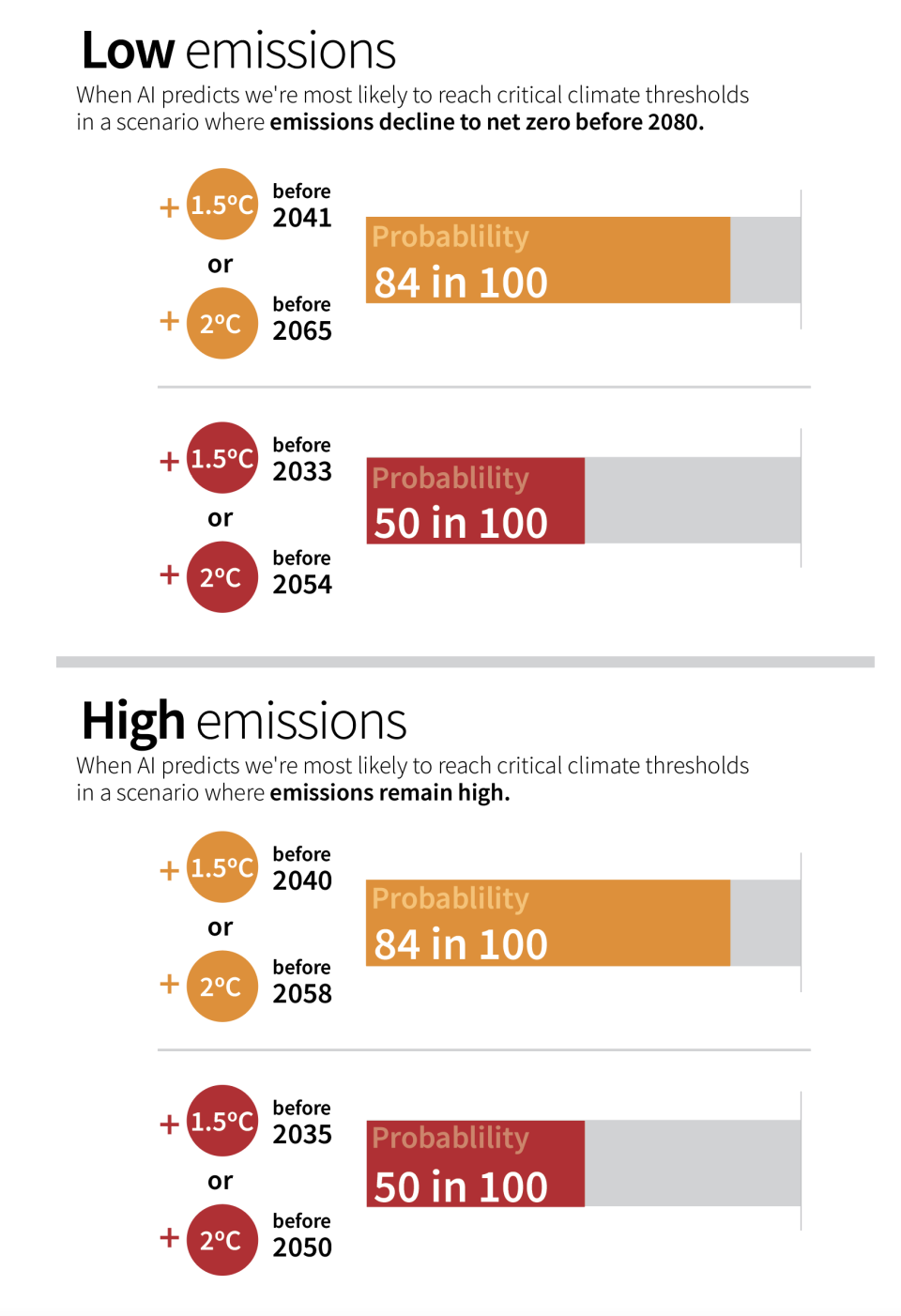Artificial intelligence predicts climate change coming faster than we recently thought, new study says
The world faces a significant risk of passing a crucial global warming threshold earlier than scientists had suggested, possibly as soon as 2050, a paper published Monday found.
The threshold is the point at which Earth's overall temperature has increased by 2.0 degrees Celsius, or 3.6 degrees Fahrenheit.
If greenhouse gas emissions remain at high levels, there's a 50% probability the world could reach that catastrophic milestone before 2050, said co-author Noah Diffenbaugh, a climate scientist at Stanford University. The chance it could reach 2.0 degrees before 2058 is 84 in 100.
Earlier estimates had put it closer to the end of the century.
How does climate change affect you?: Subscribe to the weekly Climate Point newsletter
What did the study find?
The paper, published in the Proceedings of the National Academy of Sciences, used artificial intelligence and machine learning to model how much the climate has warmed in the past and how much it's likely to warm in the future, given current levels of greenhouse gas releases.
In line with multiple previous studies, it estimates Earth probably will cross the 1.5 degree Celsius threshold between 2033 and 2035. The planet already has warmed 1.1 degrees Celsius over preindustrial times.
This latest study finds a high probability of reaching 2.0 degrees Celsius before 2065, even if the world substantially lowers greenhouse gas emissions.
Either way, that would mean today's kindergarteners would be dealing with high-impact climate changes by the time they're in their 30s.
READ MORE: Latest climate change news from USA TODAY
Why does it matter if the Earth warms a few degrees?
Even a few degrees across the entire globe means a great deal more heat in the system as a whole.
Warming of 1.5 degrees Celsius would increase heat waves, lengthen warm seasons and shorten cold seasons. If temperatures were 2.0 degrees warmer, heat extremes would more often reach critical tolerance thresholds for agriculture and health, multiple analyses have found.
"Global warming is already costing us financially," Diffenbaugh said. "That half-degree potentially means trillions of dollars in gross domestic product gone."
While globally average temperature numbers are small, they indicate much larger changes in extremes, said Gerald Meehl, a senior scientist at the National Center for Atmospheric Research who was part of the team that won the Nobel Prize in 2007 for its work on climate change.
PHOTOS: Climate change is melting ice in Greenland
Already, with today's 1.1 Celsius warming, the chance for record heat is twice as likely as it is for record cold.
"For a 1.5 Celsius warming, the chance for record heat is about 5 times as likely, and for a 2 Celsius warming, the chance is about 10 times as likely," Meehl said.

Why is this all in Celsius?
The scientific community, and almost all the rest of the world, use the Celsius temperature scale, on which 0 degrees is freezing and 100 degrees is boiling. Only the United States, the Cayman Islands and Liberia use Fahrenheit exclusively.
What is the world's climate goal?
To avoid increasing global temperatures, humanity needs to lower the amount of heat-trapping greenhouse gases (primarily carbon dioxide and methane) released into the atmosphere.
The nations of the world have agreed on the need to reduce emissions, though not how specifically. The Paris Agreement, signed in 2015, set long-term goals to guide the world's nations to substantially reduce global greenhouse gas emissions to limit the planet's temperature increase.
The legally binding international treaty sets the upper limit of warming at 2 degrees Celsius while seeking to limit the increase even further to 1.5 degrees C.
Even if humanity overshoots the greenhouse gas levels that will push global temperature over the 2.0 degree threshold, experts say, levels can be brought back down again over time, though not without significant problems.
“Every extra bit of warming matters, especially since warming of 1.5°C or higher increases the risk associated with long-lasting or irreversible changes, such as the loss of some ecosystems,” said Hans-Otto Pörtner, co-chair of the Intergovernmental Panel on Climate Change's Working Group II.
Dig deeper:
DEFINITIONS: Is climate change the same thing as global warming? Definitions explained.
EFFECTS: What are the effects of climate change? How they disrupt our daily life, fuel disasters.
This article originally appeared on USA TODAY: AI on climate change: Dire forecast on rising temperatures, study says

 money
money 